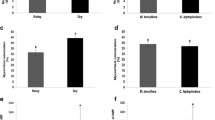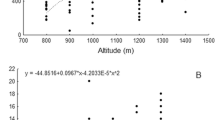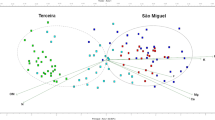Abstract
We studied seasonal variation in population attributes of arbuscular mycorrhizal (AM) fungi over 2 years in four sites of temperate grasslands of the Argentinean Flooding Pampas. The sites represent a wide range of soil conditions, hydrologic gradients, and floristic composition. Lotus glaber, a perennial herbaceous legume naturalised in the Flooding Pampas, was dominant at the four plant community sites. Its roots were highly colonised by AM fungi. Temporal variations in spore density, spore type, AM root colonisation, floristic composition and soil chemical characteristics occurred in each site and were different among sites. The duration of flooding had no effect on spore density but depressed AM root colonisation. Eleven different types of spores were recognized and four were identified. Two species dominated at the four sites: Glomus fasciculatum and Glomus intraradices. Spore density was highest in summer (dry season) and lowest in winter (wet season) with intermediate values in autumn and spring. Colonisation of L. glaber roots was highest in summer or spring and lowest in winter or autumn. The relative density of G. fasciculatum and G. intraradices versus Glomus sp. and Acaulospora sp. had distinctive seasonal peaks. These seasonal peaks occurred at all four sites, suggesting differences among AM fungus species with respect to the seasonality of sporulation. Spore density and AM root colonisation when measured at any one time were poorly related to each other. However, spore density was significantly correlated with root colonisation 3 months before, suggesting that high colonisation in one season precedes high sporulation in the next season.





Similar content being viewed by others
References
Abbott L, Robson A (1982) Infectivity of vesicular-arbuscular mycorrhizal fungi in agricultural soil. Aust J Agric Res 33:1049
Abbott L, Robson A (1991) Factors influencing the occurrence of vesicular-arbuscular mycorrhizas. Agric Ecosyst Environ 35:121–150
Anderson R, Liberta A, Dickman L (1984) Interaction of vascular plants and vesicular-arbuscular mycorrhizal fungi across a soil moisture-nutrient gradient. Oecologia 64:111–117
Aziz T, Sylvia D, Doren R (1995) Activity and species composition of arbuscular mycorrhizal fungi following soil removal. Ecol Appl 5:776–784
Bever J, Morton J, Antonovics J, Schultz P (1996) Host-dependent sporulation and diversity of arbuscular mycorrhizal fungi in a mown grassland. J Ecol 84:71–82
Bower CA, Wilcox LW (1965) Soluble salts. In: Black CA (ed) Methods of soil analysis, part 2, 2nd edn. American Society of Agronomy, Madison, Wis., pp 933–951
Bray RH, Kurtz LT (1945) Determination of total organic and available forms of phosphorus in soils. Soil Sci 59:39–45
Brown A, Bledsoe C (1996) Spatial and temporal dynamics of mycorrhizas in Jaumea carnosa, a tidal saltmarsh halophyte. J Ecol 84:703–715
Carvalho LM, Cacados I, Martiris-Loucao MA (2001) Temporal and spatial variation of arbuscular mycorrhizas in salt marsh plants of Tagus estuary (Portugal). Mycorrhiza 11:303–309
Chaneton E, Facelli J, León R (1998) Floristic changes induced by flooding on grazed lowland grasslands in Argentina. J Range Manage 41:495–499
Chapman HD (1965) Cation exchange capacity. In: Black CA (ed) Methods of soil analysis, part 2, 2nd edn. American Society of Agronomy, Madison, Wis., pp 891–901
Collantes M, Kade M, Myacszynski C, Santanatoglia O (1988) Distribución de especies en función de factores edáficos en un pastizal natural de la Depresión del Río Salado (Provincia de Buenos Aires). Studia Oecologica 5:77–93
Daget P, Poissonet J (1971) Uné méthode d’analyse phytologique des prairies. Critéres d’application. Ann Agron 22:5–41
Daniels N, Skipper H (1982) Methods for the recovery and quantitative estimation of propagules from soil. In: Methods and principles of mycorrhizal research. American Phytopathology Society, Washington DC, pp 29–35
Entry JA, Rygiewicz PT, Watrud LS, Donnelly PK (2002) Influence of adverse soil conditions on the formation and function of Arbuscular mycorrhizas. Adv Environ Res 7:123–138
Giovannetti M, Mosse B (1980) An evaluation of techniques for measuring vesicular arbuscular mycorrhizal infection in roots. New Phytol 84:489–500
Grime JP, Mackey JM, Hillier SM, Read DJ (1987) Floristic diversity in a model system using experimental microcosms. Nature 328:420–422
Hartnett D, Wilson G (1999) Mycorrhizae influence plant community structure and diversity in tallgrass prairie. Ecology 80:1187–1195
Ingham E, Wilson M (1999) The mycorrhizal colonization of six wetland species at sites differing in land use history. Mycorrhiza 9:233–235
James EK, Crawford RMM (1998) Effect of oxygen availability on nitrogen fixation by two Lotus especies under flooded conditions. J Exp Bot 49:599–609
Johnson NC, Tilman D, Wedin D (1992) Plant and soil controls on mycorrhizal fungal communities. Ecology 73:2034–2042
Khan AG (1993) Occurrence and importance of mycorrhizae (VAM) in aquatic trees of New South Wales, Australia. Mycorrhiza 3:31–38
Kleiman ID, Cogliatti DH, Santa María GE (1992) Efecto de la hipoxia sobre el crecimiento y adquisición de nutrimentos en Lolium multiflorum. Turrialba 42:210–219
Koomenn I, Grace C, Hayman DS (1987) Effectiveness of single and multiple mycorrhizal inocula on growth or clover and strawberry plants at two soil pHs. Soil Biol Biochem 16:539–544
Lugo MA, Cabello MN (2002) Native arbuscular mycorrhizal (AMF) from mountain grassland (Córdoba, Argentina) I. Seasonal variation of fungal spore diversity. Mycologia 94:579–586
Mazzanti A, Montes L, Minon D, Sarlangue H, Chepi C (1988) Utilización de Lotus tenuis en la Pampa Deprimida: resultado de una encuesta. Rev Agric Prod Anim 8:301–305
Mendoza R, Pagani E (1997) Influence of phosphorus nutrition on mycorrhizal growth response and morphology of mycorrhizae in Lotus tenuis. J Plant Nutr 20:625–639
Mendoza R, Pagani E, Pomar MC (2000) Variabilidad poblacional de Lotus glaber en relación con la absorción de fósforo en suelo. Ecol Austr 10:3–14
Mendoza R, Goldmann V, Rivas J, Escudero V, Pagani E, Collantes M, Marbán L (2002) Poblaciones de hongos micorrízicos arbusculares en relación con propiedades del suelo y planta hospedante en pastizales de Tierra del Fuego. Ecol Austr 12:9–20
Miller S (2000) Arbuscular mycorrhizal colonization of semi-aquatic grasses along a wide hydrologic gradient. New Phytol 145:145–155
Miller S, Bever J (1999) Distribution of arbuscular mycorrhizal fungi in stands of the wetland grass Panicum hemitomon along a wide hydrologic gradient. Oecologia 119:586–592
Miller S, Sharitz RR (2000) Manipulation of flooding and arbuscular mycorrhizal formation influences growth and nutrition of two semi-aquatic species. Funct Ecol 14:738–748
Mosse B, Stribley D, Le Tacon F (1981) Ecology of mycorrhizas and mycorrhizal fungi. In: Alexander M (ed) Advances in microbial ecology. Plenun Press, New York, pp 137–210
Peech M (1965) Hydrogen-ion activity, In: Black CA (ed) Methods of soil analysis, part 2, 2nd edn. American Society of Agronomy, Madison, Wis., pp 914–926
Porter WM, Abbott LK, Robson AD (1978) Field survey of the distributions of VA mycorrhizal fungi in relation to soil pH. J Appl Ecol 24:659–662
Rickerl DH, Sancho FO, Ananth S (1994) Vesicular-arbuscular endomycorrhizal colonization of wetland plants. J Environ Qual 23:913–916
Robson AD, Abbott LK (1989) The effect of soil acidity on mycrobial activity in soils. In: Robson AD (ed) Soil acidity and plant growth. Academic Press, Sydney, 99:139–165
Rowell JG, Walters DE (1978) Analysing data with repeated observations on each experimental unit. J Agric Sci 87:423–432
Smith M, Hartnett D, Wilson G (1999) Interacting influence of mycorrhizal symbiosis and competition on plant diversity in tallgrass prairie. Oecologia 121:574–582
Ter Braak CJF (1987–1992) CANOCO—a FORTRAN program for canonical community ordination. Microcomputer Power, Ithaca, N.Y.
Turner SD, Amon JP, Schneble RM, Friese CF (2000) Mycorrhizal fungi associated with plants in ground-water fed wetlands. Wetlands 20:200–204
Van der Heijden MGA, Kilronomos JN, Ursic M, Moutoglis P, Streitwolf-Engel R, Boller T, Wiemken A, Sanders IR (1998) Mycorrhizal fungal diversity determines plant biodiversity, ecosystem variability and productivity. Nature 396:69–72
Vignolio O, Fernández O, Maceira N (1996) Respuestas de Lotus tenuis y Lotus corniculatus (Leguminosae) al anegamiento en plantas de distintas edades. Rev Fac Agron La Plata 101:57–66
Vignolio O, Fernández O, Maceira N (1999) Flooding tolerance in five populations of Lotus glaber Mill. (Syn. Lotus tenuis Waldst. Et. Kit.). Aust J Agric Res 50:555–559
Young JL, Davis EA, Rose SL (1985) Endomycorrhizal fungi in breeder wheats and Triticale cultivars field grown on a fertile soil. Agron J 77:219–224
Acknowledgements
Thanks to Dra. Marta Collantes for helpful comments on the manuscript, Mr. Carlos Hernandez for field and glasshouse technical assistance and Eduardo Pagani and Juan Rivas for measuring root length colonised. Special thanks Dr. N.J. Barrow for checking the English writing.
Author information
Authors and Affiliations
Corresponding author
Rights and permissions
About this article
Cite this article
Escudero, V., Mendoza, R. Seasonal variation of arbuscular mycorrhizal fungi in temperate grasslands along a wide hydrologic gradient. Mycorrhiza 15, 291–299 (2005). https://doi.org/10.1007/s00572-004-0332-3
Received:
Accepted:
Published:
Issue Date:
DOI: https://doi.org/10.1007/s00572-004-0332-3




